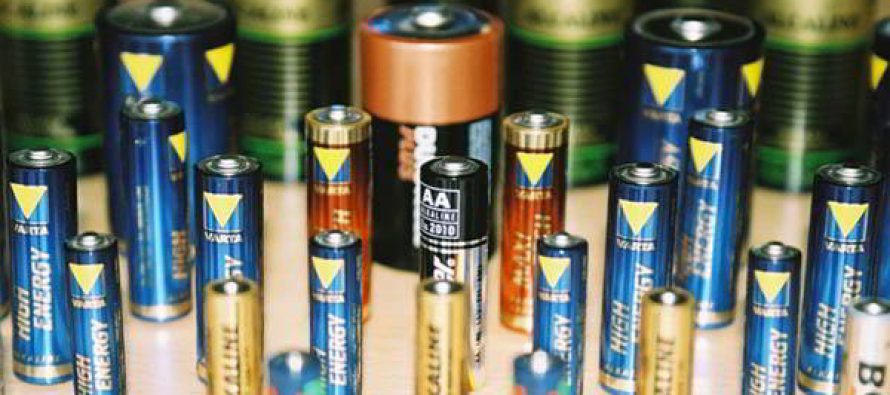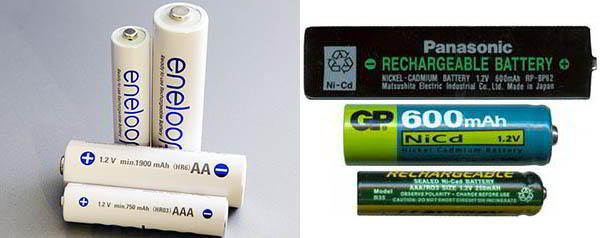

| Online: | |
| Visits: | |
| Stories: |

| Story Views | |
| Now: | |
| Last Hour: | |
| Last 24 Hours: | |
| Total: | |
Which Batteries Are Best for Survival Situations?

When it comes to most survival situations, batteries are often overlooked. Too many people assume that all they need to do is make sure their battery operated survival gear is ready to go with new alkaline batteries and that they have a fresh pack of spares. This is an unfortunate assumption!

Visual reference of common battery sizes. The black rectangular battery is the 9 volt and the red battery in the middle-right is the AAA battery.
Battery Basics: Size and Chemistry
There are five primary battery sizes in the United States: D, C, AA, AAA and 9 volt. Most batteries fall into three categories: alkaline, lithium and nickel.
Alkaline batteries are what the average person imagines when they picture a battery. There are other similar types, such as carbon zinc (aka: “heavy duty”), but we won’t get into these battery types that much because alkaline batteries should not be used in survival situations. We’ll touch more on this throughout the article.
Lithium batteries come in many varieties. There are both rechargeable and non-rechargeable types. Two of the more common rechargeable types are lithium-ion and lithium-polymer. Two common non-rechargeable types are lithium-iron disulfide (occasionally referred to as “voltage compatible lithium batteries”) and lithium-manganese dioxide (commonly referred to as CR 123A batteries).

1. Lithium-polymer batteries are often rectangular in shape.
2. AA size lithium-iron disulfide battery.
3. Three CR123A lithium-manganese dioxide batteries shown with an AA battery.
The two most common types of nickel-based batteries are NiCd (nickel cadmium) and NiMH (nickel metal hydride). NiCd is fairly old battery technology and is still sold today, but usually only available from specialty retailers. NiMH are still sold almost anywhere batteries are sold.
For the sake of brevity, we will only concern ourselves with the following two battery specifications: volt and milliampere-hour (commonly abbreviated as mAh). Without getting too technical, a volt is analogous to water pressure, such as pounds-per-square-inch, while mAh is analogous to water flow, such as gallons-per-minute. The typical AA size alkaline battery can produce 1.5 volts and holds about 2,500 mAh of electricity.
Batteries for Short-Term Survival Situations
In a survival situation lasting up to a few weeks, you’ll want to use lithium-iron disulfide batteries in AAA or AA size. These are currently sold as Energizer Lithium batteries in the United States.
If you have any flashlights, radios, signaling devices, etc. that need batteries, do you best to find devices that can use these batteries. Energizer Lithium batteries are great for short-term survival situations for several reasons:
- They handle temperature extremes much better than most batteries on the market. In freezing temperatures, alkaline and nickel based batteries won’t work or will have greatly reduced performance.
- They are lightweight.
- They have a very long shelf life. Energizer Lithium batteries are advertised has having a 20 year shelf life.
- They don’t leak. Alkaline batteries often leak, leaving a corrosive residue.
- Lithium-iron disulfide batteries can produce more power for a longer period of time than alkaline batteries. While an alkaline battery is around 1.5 volts, a lithium-iron disulfide battery has about 1.6 volts (for the AA and AAA sizes).
Related: How to Get Power Out of Your Dead Batteries
So what are the disadvantages? Here are a few:
- They only come in AAA, AA and 9 volt sizes. You may have survival equipment that only uses C or D batteries, although this can often be remedied by using a battery spacer.
- Compared to alkaline batteries, lithium-iron disulfide batteries are more expensive.
- The slightly higher voltage could harm some electronic devices. This is going to be a rare situation, but it could arise, such as when powering an insulin pump or other device with sensitive electronics.
- They’re not rechargeable.
- You might be wondering about CR123A lithium batteries – why not use those, especially since they have more power at 3.0 volts? You can, as they provide excellent performance. However, more devices use AA or AAA batteries than CR123A batteries. Additionally, CR123A batteries are more expensive and typically harder to find.
Batteries for Long-Term Survival Situations
If you need batteries to power devices in an extended survival or off-grid situation, you’re going to need a rechargeable option. I recommended the low self-discharge (LSD) NiMH battery, and here’s why.
First, if you’re living off the grid for several years or more, you’re most likely going to need to recharge your batteries from a renewable source, like solar, hydro or wind. Due to the very nature of these power sources, you’re unlikely to have a steady, reliable and consistent flow of electricity. As a result, you need batteries that are forgiving to interruptions or dips in power when recharging.
NiCd batteries are the most forgiving when it comes to inconsistent charging, but only have about one-half to one-third the mAh of a similarly sized NiMH battery.
Second, LSD NiMH batteries will hold their charge while being stored for a very long time. For example, eneloops, which are a type of LSD NiMH battery, will have 70% of its original charge after 10 years. Most “regular” NiMH batteries will lose most of its charge after only one year.
Third, LSD NiMH batteries perform well in high current draw applications, much better than alkaline and comparable to lithium based batteries.
There is essentially just one disadvantage to using LSD NiMH batteries: It provides only 1.2 volts. To put that in perspective, alkaline batteries use 1.5 volts, and lithium batteries use between 1.6 and 3.7 volts.
Related: How to Build Your Own Solar Panels
So why not use rechargeable lithium batteries?
There are plenty of issues:
- They require special charging algorithms that don’t get along well with unsteady electricity flow. This is why many solar charging systems have a built-in battery to serve as a “buffer” between the solar cells and the device being charged.
- Most rechargeable lithium batteries only last about 1,000 cycles or less; usually the cycle life is closer to 500 or so. LSD NiMH batteries, such as eneloops, have lives that range between 2,000 and 3,000 cycles. (A “cycle” refers to one charge and discharge event. For instance, if you have a laptop that’s fully charged, then you use it until the battery runs out, then you recharge it to full capacity, that represents one cycle.)
- They’re a fire risk. Perhaps you’ve heard a few recent news stories about batteries catching fire or exploding? Those are lithium-based batteries, not nickel-based.
- In a survival situation, you’ll want as many devices as possible capable of using the same battery. Since there is such a wide range of rechargeable lithium options, it’ll be harder to standardize the batteries among the devices.
Why Are Alkaline Batteries Bad in Survival Situations?
Alkalines are a no-no, because they leak, can’t be stored as long as lithium-iron disulfide or LSD NiMH batteries and have poor low-temperature performance. Leaking is a problem, not just because the battery you thought you can use is now bad, but because the leakage can potentially damage the device it’s in. If the leakage has gone on long enough, the device could be ruined or at best, require thorough cleaning.
Last Piece of Battery Advice

Eneloop branded C and D battery spacers for AA batteries.
Preparing for survival scenarios can be made a little easier by using electronic devices that utilize the same batteries, specifically the AA size. This allows batteries to be interchangeable between your survival equipment and you only have to worry about having a supply of one type of batteries. There’s also the fact that the average retailer will often have more AA batteries for sale than any other type.
If you must use a device that takes C or D batteries, you can always use a spacer. For C sized applications, you can make your own spacer out of anything that will widen the AA battery. After all, a C battery is the same length as the AA battery, just wider. For a D battery, a proper spacer is recommended.
Lost Remedies from Our Forefathers




Super Size Your Battery Run Time: D Cell Battery Packs
http://www.instructables.com/id/Super-Size-Your-Battery-Run-Time-D-Cell-Battery-Pa/
LED Lighting: One “Dead” D Cell At A Time
http://www.instructables.com/id/LED-Lighting-One-D-Cell-at-a-Time/